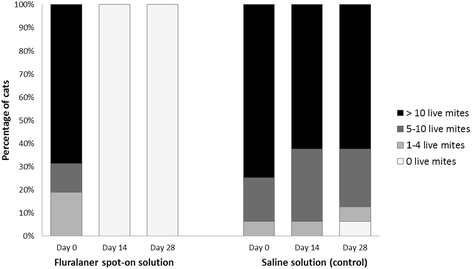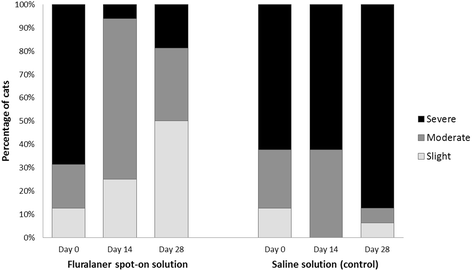Efficacy of fluralaner against Otodectes cynotis infestations in dogs and cats
- PMID: 28093080
- PMCID: PMC5240227
- DOI: 10.1186/s13071-016-1954-y
Efficacy of fluralaner against Otodectes cynotis infestations in dogs and cats
Abstract
Background: The efficacy of fluralaner for the treatment of Otodectes cynotis infestations in dogs and cats was evaluated after oral (dogs) or topical administration (dogs and cats). Twenty-four dogs and sixteen cats were experimentally infested with O. cynotis and randomly allocated to equal sized groups (n = 8/group). Dog groups were treated once, either orally with fluralaner at a minimum dose of 25 mg/kg body weight, topically with fluralaner at a dose of 25 mg/kg body weight or topically with saline solution (control). Cat groups were treated once, either topically with fluralaner at a dose of 40 mg/kg body weight or topically with saline solution. Ears of all animals were examined otoscopically for live visible mites and the amount of debris and cerumen before, and 14 and 28 days after treatment. Twenty-eight days after treatment, animals were sedated and both ears were flushed to obtain the total number of live mites per animal. The efficacy was calculated, based on the results of the ear flushing, by comparing mean live mite counts in the fluralaner treated groups versus the saline solution treated group.
Results: A single topical treatment of cats with fluralaner reduced the mean mite counts by 100% (P < 0.001) at 28 days after treatment. Similarly, a single oral or topical treatment of dogs with fluralaner reduced the mean mite counts by 99.8% (P < 0.001) at 28 days after treatment. Cats treated topically with fluralaner had no mites visible during otoscopic examination at either 14 or 28 days after treatment. All dogs treated orally or topically with fluralaner had no mites visible during otoscopic examination at 28 days after treatment. At 14 days after treatment, only 1-2 mites were visible in three dogs (oral treatment: 2 dogs, topical treatment: 1 dog). All fluralaner-treated animals showed improvement in the amount of cerumen exudation compared with observations performed before treatment. No treatment related adverse events were observed in any dogs or cats enrolled in these studies.
Conclusions: In this study, fluralaner administered topically to cats and orally or topically to dogs was highly effective against Otodectes cynotis mite infestations.
Keywords: Bravecto™; Bravecto™ spot-on solution; Cat; Chewable tablets; Dog; Ear mite; Efficacy; Fluralaner; Oral; Otocariosis; Otodectes cynotis; Topical.
Figures




Similar articles
-
Efficacy of fluralaner plus moxidectin (Bravecto® Plus spot-on solution for cats) against Otodectes cynotis infestations in cats.Parasit Vectors. 2018 Nov 19;11(1):595. doi: 10.1186/s13071-018-3167-z. Parasit Vectors. 2018. PMID: 30449272 Free PMC article.
-
Efficacy of fluralaner administered either orally or topically for the treatment of naturally acquired Sarcoptes scabiei var. canis infestation in dogs.Parasit Vectors. 2016 Jul 7;9(1):392. doi: 10.1186/s13071-016-1670-7. Parasit Vectors. 2016. PMID: 27387742 Free PMC article.
-
Efficacy of fluralaner spot-on solution for the treatment of Ctenocephalides felis and Otodectes cynotis mixed infestation in naturally infested cats.BMC Vet Res. 2019 Jan 16;15(1):28. doi: 10.1186/s12917-019-1775-2. BMC Vet Res. 2019. PMID: 30651107 Free PMC article.
-
[Otodectes cynotis infestation of dogs and cats: biology of the agent, epidemiology, pathogenesis and diagnosis and case description of generalized mange in dogs].Tierarztl Prax. 1988;16(4):409-15. Tierarztl Prax. 1988. PMID: 3065982 Review. German.
-
Evidence-based veterinary dermatology: a review of published studies of treatments for Otodectes cynotis (ear mite) infestation in cats.Vet Dermatol. 2016 Aug;27(4):221-e56. doi: 10.1111/vde.12340. Epub 2016 Jun 20. Vet Dermatol. 2016. PMID: 27324289 Review.
Cited by
-
Chronic Otitis in Cats: Clinical management of primary, predisposing and perpetuating factors.J Feline Med Surg. 2021 May;23(5):433-446. doi: 10.1177/1098612X211007072. J Feline Med Surg. 2021. PMID: 33896249 Free PMC article. Review.
-
Efficacy of topically administered fluralaner or imidacloprid/moxidectin on dogs with generalised demodicosis.Parasit Vectors. 2019 Jan 25;12(1):59. doi: 10.1186/s13071-018-3230-9. Parasit Vectors. 2019. PMID: 30683143 Free PMC article.
-
Insights into the prevalence and diagnosis of feline otoacariasis in Egypt.J Parasit Dis. 2025 Mar;49(1):193-206. doi: 10.1007/s12639-024-01746-3. Epub 2024 Oct 10. J Parasit Dis. 2025. PMID: 39975603
-
Effectiveness of a fluralaner spot-on formulation in a case of feline demodicosis due to Demodex cati.JFMS Open Rep. 2022 Jan 27;8(1):20551169211069529. doi: 10.1177/20551169211069529. eCollection 2022 Jan-Jun. JFMS Open Rep. 2022. PMID: 35111330 Free PMC article.
-
Isoxazolines for treating canine and feline otodectic mange; feline demodicosis, lynxacariasis, lice infestation, and notoedric mange (scabies); demodicosis in hamsters; and sarcoptic and psoroptic manges in rabbits.Can Vet J. 2023 Nov;64(11):1066-1070. Can Vet J. 2023. PMID: 37915780 Free PMC article. No abstract available.
References
MeSH terms
Substances
LinkOut - more resources
Full Text Sources
Other Literature Sources
Miscellaneous

